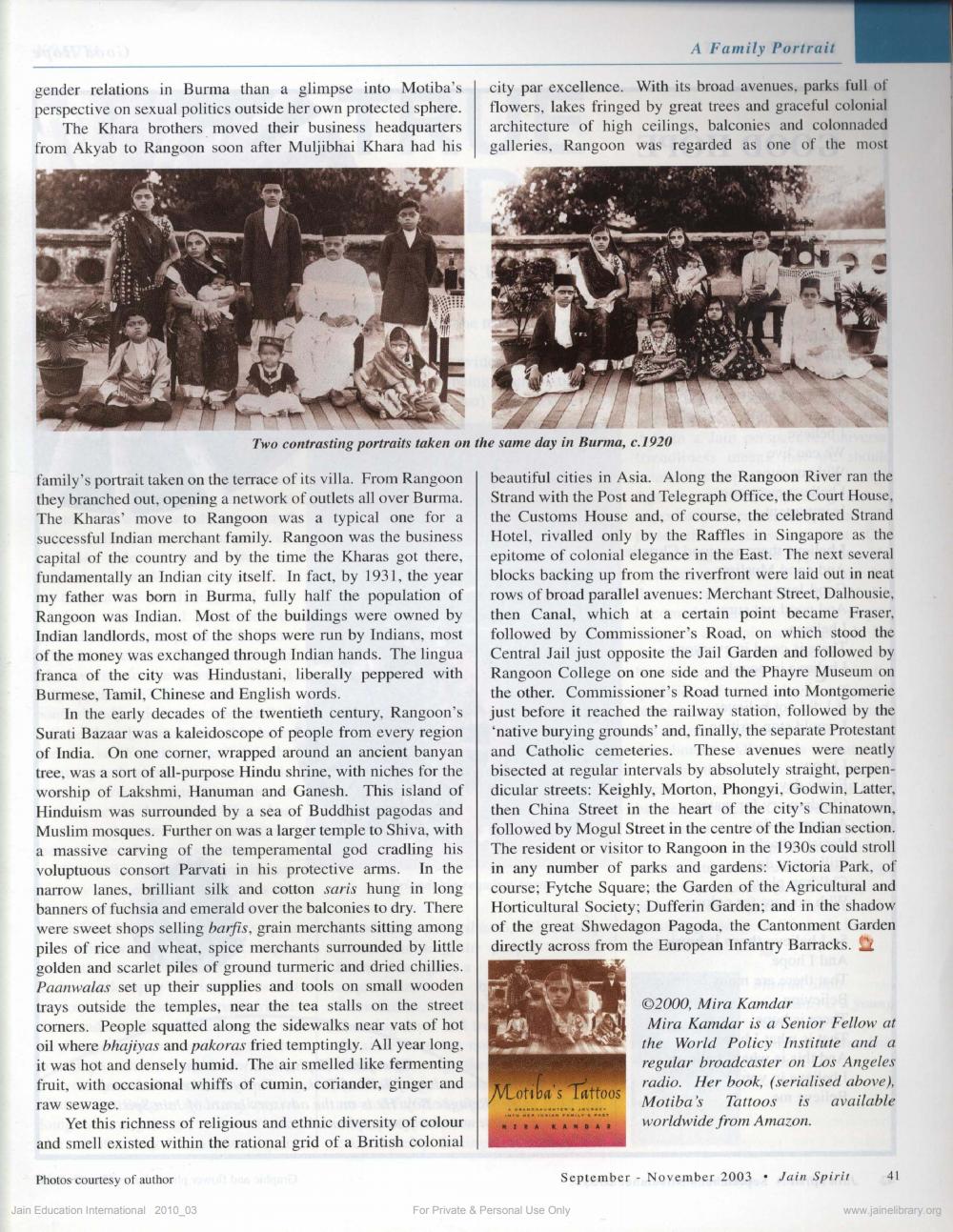Book Title: Jain Spirit 2003 10 No 16
Author(s): Jain Spirit UK
Publisher: UK Young Jains
View full book text
________________
A Family Portrait
gender relations in Burma than a glimpse into Motiba's | perspective on sexual politics outside her own protected sphere.
The Khara brothers moved their business headquarters from Akyab to Rangoon soon after Muljibhai Khara had his
city par excellence. With its broad avenues, parks full of flowers, lakes fringed by great trees and graceful colonial architecture of high ceilings, balconies and colonnaded galleries, Rangoon was regarded as one of the most
Two contrasting portraits taken on the same day in Burma, c.1920
family's portrait taken on the terrace of its villa. From Rangoon they branched out, opening a network of outlets all over Burma. The Kharas' move to Rangoon was a typical one for a successful Indian merchant family. Rangoon was the business capital of the country and by the time the Kharas got there, fundamentally an Indian city itself. In fact, by 1931, the year my father was born in Burma, fully half the population of Rangoon was Indian. Most of the buildings were owned by Indian landlords, most of the shops were run by Indians, most of the money was exchanged through Indian hands. The lingua franca of the city was Hindustani, liberally peppered with Burmese, Tamil, Chinese and English words.
In the early decades of the twentieth century, Rangoon's Surati Bazaar was a kaleidoscope of people from every region of India. On one corner, wrapped around an ancient banyan tree, was a sort of all-purpose Hindu shrine, with niches for the worship of Lakshmi, Hanuman and Ganesh. This island of Hinduism was surrounded by a sea of Buddhist pagodas and Muslim mosques. Further on was a larger temple to Shiva, with a massive carving of the temperamental god cradling his voluptuous consort Parvati in his protective arms. In the narrow lanes, brilliant silk and cotton saris hung in long banners of fuchsia and emerald over the balconies to dry. There were sweet shops selling barfis, grain merchants sitting among piles of rice and wheat, spice merchants surrounded by little golden and scarlet piles of ground turmeric and dried chillies. Paanwalas set up their supplies and tools on small wooden trays outside the temples, near the tea stalls on the street corners. People squatted along the sidewalks near vats of hot oil where bhajiyas and pakoras fried temptingly. All year long. it was hot and densely humid. The air smelled like fermenting fruit, with occasional whiffs of cumin, coriander, ginger and raw sewage.
Yet this richness of religious and ethnic diversity of colour and smell existed within the rational grid of a British colonial
beautiful cities in Asia. Along the Rangoon River ran the Strand with the Post and Telegraph Office, the Court House, the Customs House and, of course, the celebrated Strand Hotel, rivalled only by the Raffles in Singapore as the epitome of colonial elegance in the East. The next several blocks backing up from the riverfront were laid out in neat rows of broad parallel avenues: Merchant Street, Dalhousie, then Canal, which at a certain point became Fraser, followed by Commissioner's Road, on which stood the Central Jail just opposite the Jail Garden and followed by Rangoon College on one side and the Phayre Museum on the other. Commissioner's Road turned into Montgomerie just before it reached the railway station, followed by the 'native burying grounds' and, finally, the separate Protestant and Catholic cemeteries. These avenues were neatly bisected at regular intervals by absolutely straight, perpendicular streets: Keighly, Morton, Phongyi, Godwin, Latter, then China Street in the heart of the city's Chinatown, followed by Mogul Street in the centre of the Indian section, The resident or visitor to Rangoon in the 1930s could stroll in any number of parks and gardens: Victoria Park, of course; Fytche Square; the Garden of the Agricultural and Horticultural Society: Dufferin Garden; and in the shadow of the great Shwedagon Pagoda, the Cantonment Garden directly across from the European Infantry Barracks. 2
©2000, Mira Kamdar Mira Kamdar is a Senior Fellow at the World Policy Institute and a regular broadcaster on Los Angeles radio. Her book, (serialised above), Motiba's Tattoos is available worldwide from Amazon.
M
otiba's 1
attoos
Photos courtesy of author
September - November 2003 . Jain Spirit
41
Jain Education International 2010_03
For Private & Personal Use Only
www.jainelibrary.org

Page Navigation
1 ... 41 42 43 44 45 46 47 48 49 50 51 52 53 54 55 56 57 58 59 60 61 62 63 64 65 66 67 68
